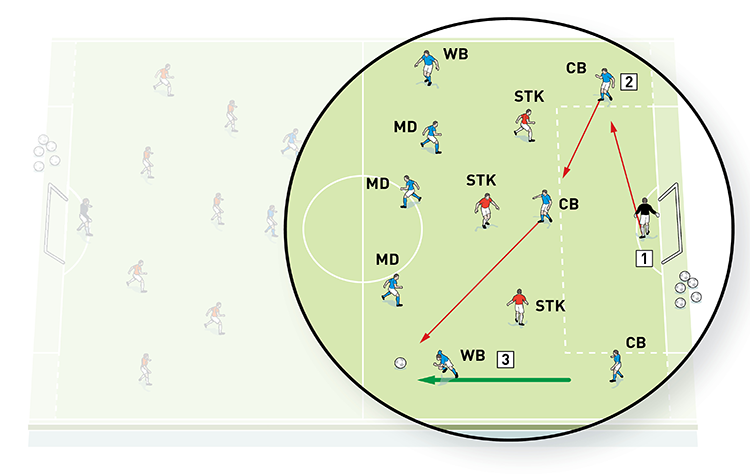




OUR BEST EVER OFFER - SAVE £100/$100
JOIN THE WORLD'S LEADING PROFESSIONAL DEVELOPMENT PROGRAMME
- 12 months membership of Elite Soccer
- Print copy of Elite Player & Coach Development
- Print copy of The Training Ground
You are viewing 1 of your 1 free articles
Match preparation
This session is focussed on preparing players for an upcoming opponent, specifically with regard to getting them to understand their options for playing out from the goalkeeper against the exact formation they are likely to encounter. It also prepares them to play against the opposition when outnumbered in certain areas of the pitch.
| Area | Full pitch |
| Equipment | Balls, bibs, cones, 2 full size goals |
| No. of Players | 20 players + 2 goalkeepers |
| Session Time |
Part A: 15mins, Part B: 15mins, Part C: 15mins |
This session is focussed on preparing players for an upcoming opponent, specifically with regard to getting them to understand their options for playing out from the goalkeeper against the exact formation they are likely to encounter. It also prepares them to play against the opposition when outnumbered in certain areas of the pitch.
I like my teams to play an aggressive, penetrative and well-organised style of football and I try to give players an understanding of the scenarios they are going to face during the next game. I want players to be conscious of what the opponents are likely to do.
Football is made up of both predictable movements and unpredictable events. The predictable movements include set plays, patterns of play and the use of passing lanes, while the unpredictable events include things such as the skills of the individual player, the weather conditions and so on.
During the week leading up to a game, I want my players to have built a picture of all the predictable movements of the game, so all of their mental energy will be focused on the unpredictable.
If we were playing on a Saturday, I would run this at training on a Thursday.
What do I get the players to do?
Part A: the set-up
We set up between the penalty boxes, using the full width of the pitch. We have a goal at each end, and a ready supply of balls around the pitch.
We’re using 20 outfield players and two goalkeepers, playing 11v11, as shown [1]. As we’re setting up to face a specific upcoming opponent, we get one team to line-up in the formation we expect the opposition to use (here we’re using 4-3-3) and they have unlimited touches. We coach the other team (here set-up in a 3-5-2 formation) and we are restricting these players to two-touch, although this can change depending on the style of aggression of the opponent – and by that I mean how aggressively they press the goal kick and how many passes on average it takes before they win the ball back.
1

2. The blues set up in a 3-5-2 formation and are two-touch
These drills are to make players aware of how we want them to play out from the back in our next match. Before this part of the session begins, I underline to the players our pressing area (the area in which we press forwards with the ball). I also explain which players should begin the move forwards and how they do it. I also make them understand what happens and what they do if they break past the first pressing aggression of the opposition and progress into the central third of the pitch.
We then spend 15 minutes working on the below options of playing out from the back.
Playing out option 1
In the first drill the goalkeeper plays out from the back through two central defenders who combine to pass out to one of the wing backs, who has moved into space to receive, as shown [2a]. The midfielders and the strikers also move to find space to support the wing back, who plays the ball inside to combine with his team mates and then receives the ball back higher up the pitch, as shown [2b].
2a

2. The right-sided centre back combines with the most central of the centre backs to work the ball out to the left wing back
3. The left wing back advances past the opposition striker to find space to receive the pass
2b

2. A striker combines with the midfielder to pass back to the wing back, who has advanced higher up the pitch to receive
3. The strikers move forward to find space to receive a cross from the wing back
We let them play for a while and then we stop play and restart the drill from the goal kick, so they continue to focus on their passing patterns for playing out from the back and working the ball through the middle third.
Playing out option 2
The second option of playing out involves passing to one of the centre backs, who receives and moves inside with the ball to find the space to pass. He then plays down the line to the wing back, who combines with a midfielder to pass forwards into the path of second midfielder, as shown [3a]. On receiving the pass, the second midfielder takes the ball over the halfway line and plays into the path of one of the two advancing strikers, as shown [3b]. As before, we allow them to play for a while, before restarting play with a goal kick.
3a

2. The right wing back combines with a midfielder to work the ball forward to a second midfielder on the halfway line
3b

What do I get the players to do next?
Part B: playing outnumbered
We use the same set-up again but now we focus on simulating a situation when we are outnumbered in certain areas of the pitch [not shown].
We start from the kick off and we play an 11v11 game as normal for 15 minutes. However, at certain points we call for two or three of our players to kneel for five seconds, leaving the team we are coaching outnumbered. We do this in areas where we could be outnumbered in a match, or imbalanced because some players are tiring.
We usually remove two players who are possibly connected in the defensive phase, like a full back and a winger, or a chain of three players. We set the players a question – how do we react if this happens? The drill is interrupted and I let them discuss solutions and then ask them to implement their plan when we restart the game.
How would you put this in a game situation?
Part C: 11v11 game
We finish the activities by asking the players to combine what has been learnt from the first two parts of the session into an 11v11 game, played between the penalty boxes of the pitch with a goal at each end, as shown [4].
4

2. A central defender receives and combines with a midfielder to work the ball out wide to the right wing back, avoiding the press of the opposing striker
3. A second midfielder drops back into space, receives the ball and plays forwards to the striker
For this game, both teams have unlimited touches. We play for 15 minutes.
What are the key things to look out for?
We want to see that players can think for themselves as much as possible. They must show they understand the predictable elements of the game and what they have to do in certain situations, but they must also demonstrate they have the intelligence to interpret and react to less predictable situations.
We like to let the players find out the solutions to problems themselves and we want to see them coaching each other, either when they are playing or when we stop the game.
Related Files
Editor's Picks
Attacking transitions
Deep runs in the final third
Using the goalkeeper in build-up play
Intensive boxes drill with goals
Penetrating the final third
Creating and finishing
My philosophy
Pressing initiation
Compact team movement
Coaches' Testimonials

Alan Pardew

Arsène Wenger

Brendan Rodgers

Carlos Carvalhal

José Mourinho

Jürgen Klopp

Pep Guardiola

Roy Hodgson

Sir Alex Ferguson

Steven Gerrard
Coaches' Testimonials

Gerald Kearney, Downtown Las Vegas Soccer Club

Paul Butler, Florida, USA

Rick Shields, Springboro, USA

Tony Green, Pierrefonds Titans, Quebec, Canada
Join the world's leading coaches and managers and discover for yourself one of the best kept secrets in coaching. No other training tool on the planet is written or read by the calibre of names you’ll find in Elite Soccer.
In a recent survey 92% of subscribers said Elite Soccer makes them more confident, 89% said it makes them a more effective coach and 91% said it makes them more inspired.
Get Monthly Inspiration
All the latest techniques and approaches
Since 2010 Elite Soccer has given subscribers exclusive insight into the training ground practices of the world’s best coaches. Published in partnership with the League Managers Association we have unparalleled access to the leading lights in the English leagues, as well as a host of international managers.
Elite Soccer exclusively features sessions written by the coaches themselves. There are no observed sessions and no sessions “in the style of”, just first-hand advice delivered direct to you from the coach.







